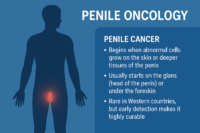Swarn Bhupati Ras is a time-honored Ayurvedic formulation classified under Rasayana and Rasashastra medicines, known for its potent rejuvenative and immune-modulating properties. Originating from classical Ayurvedic texts such as Rasendra Sara Sangraha and Bhaishajya Ratnavali, this formulation represents a pinnacle in ancient Indian alchemical medicine where purified metals and minerals are combined to address chronic, degenerative, and infectious diseases [1].
Unlike ordinary herbal supplements, Swarn Bhupati Ras incorporates Swarna Bhasma (Gold calx), along with other synergistic ingredients like Abhrak Bhasma, Loha Bhasma, Rasasindoor, and Shuddha Gandhaka. These ingredients are not merely processed for detoxification but undergo specific Samskara procedures that enhance their bioavailability, safety, and efficacy when administered correctly [2].
This formulation is traditionally regarded as a royal Rasayana, once reserved for warriors, kings, and those undergoing rapid depletion of vitality due to prolonged illnesses such as Rajayakshma (a condition analogous to tuberculosis or chronic immune exhaustion). Today, modern clinicians and integrative health practitioners are revisiting Swarn Bhupati Ras for its multi-system rejuvenative potential, particularly in conditions like HIV, herpes, long COVID, cancer fatigue, autoimmune dysfunction, and age-related degeneration [3].
As science begins to validate the therapeutic properties of metals like Gold and Mica in nanoparticulate form, this ancient medicine stands at the frontier of integrative antiviral and adaptogenic therapies. What sets Swarn Bhupati Ras apart is not only its ability to repair and nourish depleted Dhatus (tissues) but also its capacity to reawaken the immune system at the Ojas (vital essence) level — a concept deeply rooted in Ayurvedic healing philosophy [4].
Classical Composition
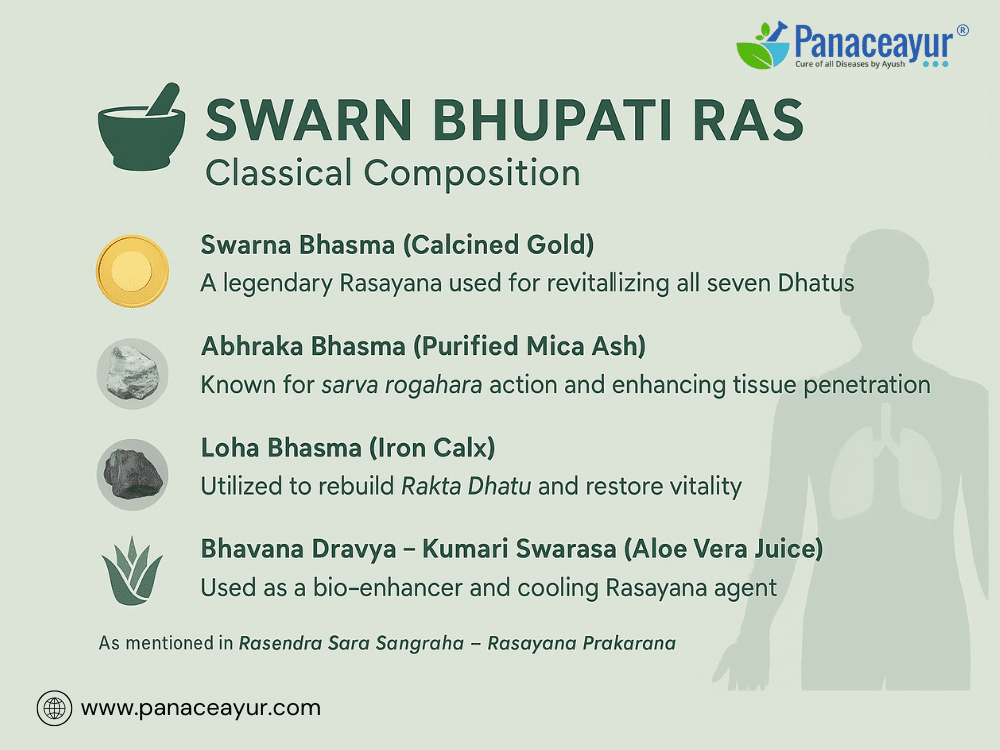
Swarn Bhupati Ras is a sophisticated Ayurvedic Rasayana composed of precious metals, herbomineral ingredients, and bio-enhancers, all processed through advanced Rasashastra techniques to ensure safety, efficacy, and deep tissue penetration. Each component is carefully selected to synergistically rebuild Dhatus (tissues), enhance Ojas (immunity), and eliminate stubborn pathogens from the body [5].
Key Ingredients and Their Functions
- Swarna Bhasma (Calcined Gold)
A legendary Rasayana used for revitalizing all seven Dhatus. It improves immunity, acts as a catalyst for other drugs (Yogavahi), and is traditionally prescribed for chronic fatigue, viral infections, and neurodegenerative conditions [6]. - Abhraka Bhasma (Purified Mica Ash)
Known for Sarva Rogahara (universal healing) action, Abhraka Bhasma enhances respiratory, reproductive, and neurological functions. Its bioavailability properties make it ideal for delivering micronutrients deep into tissues [7]. - Loha Bhasma (Iron Calx)
Used to rebuild Rakta Dhatu (blood tissue) and restore vitality in conditions involving anemia, weakness, or post-viral recovery. It also supports liver detox and cellular oxygenation [8]. - Rajata Bhasma (Silver Calx)
Though not always included in all classical variants, Rajata Bhasma is an occasional addition for its antimicrobial and cooling properties, helping balance excess Pitta and support immunity [9]. - Rasasindoor (Red Sulphide of Mercury)
A powerful compound known for quick action (Ashukari) and deep tissue reach (Sookshma). When properly purified, it acts as a rejuvenator and carrier that enhances the potency of the other Bhasmas [10]. - Shuddha Gandhaka (Purified Sulphur)
Balances Doshas and aids skin detoxification, viral clearance, and immune modulation. It also facilitates better absorption of metallic components without toxicity [11]. - Shuddha Parada (Purified Mercury)
Central to all Rasa preparations, purified Parada enhances Rasayana activity and potentiates the bio-efficiency of all other components [12]. - Bhavana Dravya – Kumari Swarasa (Aloe Vera Juice)
The entire formulation undergoes Bhavana (wet grinding) with Aloe Vera juice. This not only purifies but also enhances the cooling, Rasayana, and skin-regenerating effects of the medicine [13].
Traditional Textual Source
- Mentioned in Rasendra Sara Sangraha – Rasayana Prakarana
- Cross-referenced in Bhaishajya Ratnavali – Jirna Jwara and Kushtha Chikitsa chapters
Swarn Bhupati Ras is crafted through multi-level purification and calcination (Shodhana and Marana) methods, which transform these potent metals into non-toxic, bio-compatible forms — a process that modern nanomedicine is just beginning to understand [14].
Preparation Methodology
The preparation of Swarn Bhupati Ras follows the traditional principles of Rasashastra, where each metallic and mineral component is subjected to meticulous detoxification and transformation processes to ensure maximum therapeutic benefit and zero toxicity. This begins with Shodhana—the purification of metals and minerals such as gold, mica, iron, mercury, and sulphur using herbal decoctions, cow’s urine, and lime-based solutions. These steps are not merely symbolic rituals but pharmacologically relevant methods that chemically alter the raw materials to remove harmful residues while enhancing their absorbability [15].
After purification, the ingredients undergo Mardana, a grinding procedure in which the purified substances are finely triturated using a mortar and pestle, often with the addition of a liquid medium known as Bhavana Dravya. In the case of Swarn Bhupati Ras, Kumari Swarasa (Aloe vera juice) is the chosen liquid, imparting Rasayana properties and aiding in the binding and transformation of metals into a non-toxic bioavailable form [16]. This Bhavana process is repeated for several days, sometimes extending up to a month, to ensure that the herbal liquid thoroughly penetrates the metallic matrix. Each round of Bhavana deepens the integration of the Rasayana into the body-like texture, enhancing its Sookshma (subtle) and Vyavayi (pervasive) qualities [17].
Once this phase is complete, the material undergoes Marana, which is incineration at carefully controlled temperatures using a closed earthen apparatus called Sharava Samput. This step is repeated multiple times depending on the metal involved—gold requires extensive calcination to achieve a soft, red or pinkish Bhasma form that passes classical tests such as Varitaratwa (floating on water) and Rekhapurnata (entering the lines of the fingers) [18]. These tests confirm the absence of free metal particles and ensure particle sizes are reduced to nanoscale for safe human consumption [19].
Throughout the preparation, strict guidelines from classical Rasashastra texts such as Rasendra Sara Sangraha and Rasa Tarangini are followed to avoid contamination, maintain Prakriti-based compatibility, and preserve the Rasayana potency of the end product [20]. The final product—Swarn Bhupati Ras—is a fine reddish-gold powder with a subtle metallic sheen, highly stable and capable of crossing biological barriers to deliver its medicinal effects to the deepest Dhatus (tissues) [21].
Modern researchers have found that when traditionally prepared, such formulations exhibit nanoparticulate structures embedded in an organic matrix, confirming the ancient claims of enhanced bioavailability and systemic action without toxicity [22].
Ayurvedic Pharmacodynamics
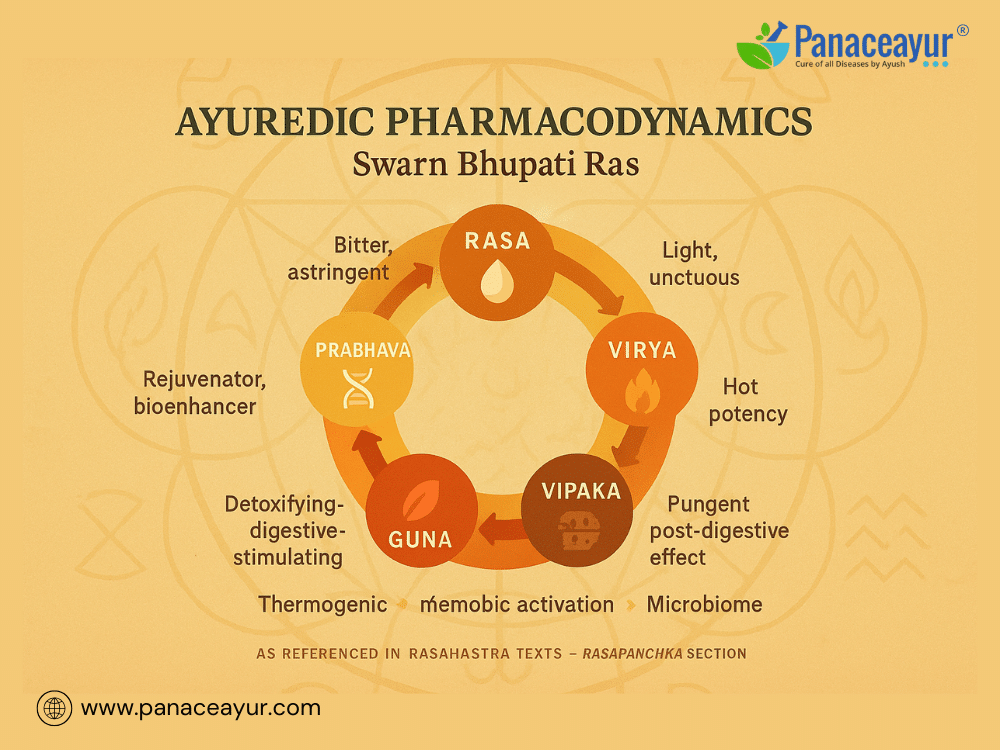
Swarn Bhupati Ras exerts its therapeutic effects by balancing the Tridosha—Vata, Pitta, and Kapha, while simultaneously strengthening all seven Dhatus. According to Ayurvedic pharmacology, its core actions are guided by the Rasapanchaka system: Rasa (taste), Guna (qualities), Virya (potency), Vipaka (post-digestive effect), and Prabhava (unique action). The Rasa of Swarn Bhupati Ras is primarily Tikta (bitter) and Kashaya (astringent), which contribute to its ability to cleanse and tone tissues, particularly effective in chronic inflammation and degeneration [23]. The Guna, or physical qualities, are Laghu (light) and Snigdha (unctuous), allowing it to be both penetrating and nourishing—a rare combination that supports deep tissue healing without aggravating Vata [24].
Its Virya, or pharmacological potency, is classified as Ushna (hot), enabling it to increase Agni (digestive/metabolic fire), remove Aama (toxins), and invigorate sluggish channels—especially important in chronic viral or autoimmune conditions marked by fatigue and stagnation [25]. The Vipaka, or post-digestive transformation, is Katu (pungent), reinforcing its detoxifying and digestive-stimulating action at the metabolic level. This is critical in reversing the buildup of metabolic residue and promoting the proper assimilation of nutrients in chronically ill patients [26].
The true therapeutic brilliance of Swarn Bhupati Ras, however, lies in its Prabhava—its special Rasayana effect that goes beyond its elemental properties. The formulation acts as a Yogavahi, a substance that enhances the bioactivity of other medications administered alongside it. This is primarily attributed to Swarna Bhasma and Rasasindoor, both of which are known in classical texts to enhance the cellular uptake of herbs and minerals, targeting the precise Dhatus affected by disease [27].
Swarn Bhupati Ras is particularly Dhatu-specific in its action. It nourishes Rasa (plasma), Rakta (blood), Mamsa (muscle), and Ojas (immunological essence) simultaneously. Its impact on Ojas—considered the substrate of immunity and vitality—is of utmost importance in conditions like rajayakshma, herpes, HIV, or post-viral syndromes, where immune intelligence must be restored from within [28].
In contemporary terms, these actions suggest immunomodulatory, adaptogenic, and antiviral effects that act on both systemic and cellular levels. Its pharmacodynamics align with Ayurvedic principles of rejuvenation and balance, making it suitable not just for disease reversal but for prevention in vulnerable individuals [29].
Indications and Classical Uses
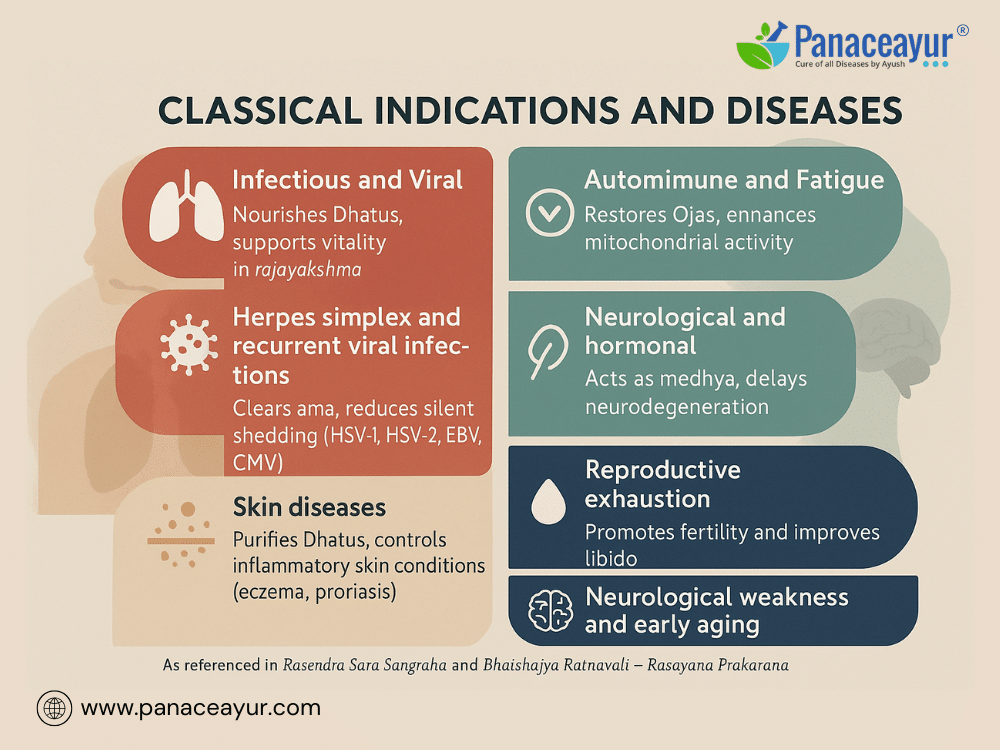
Swarn Bhupati Ras is regarded in classical Rasashastra as a high-grade Rasayana prescribed in severe, chronic, and degenerative disorders where tissue depletion and immune collapse are evident. Its applications span a wide range of conditions, both described in classical Ayurvedic terminology and correlated with modern disease profiles. The formulation’s strength lies in its deep Dhatu rejuvenation, viral detoxification, and ability to restore Ojas—the body’s essence of immunity and vitality [30].
According to Ayurvedic scriptures and clinical practice, it is indicated in the following conditions:
- Tuberculosis (Rajayakshma): A primary indication in texts like Rasendra Sara Sangraha, where it is used to halt progressive weight loss, night sweats, immune collapse, and exhaustion. Its Rasayana effect nourishes all Dhatus and restores lost vitality [31].
- Chronic Fevers (Jirna Jwara): Especially effective in low-grade, unresolved fevers linked with Aama buildup, latent infection, or post-viral syndromes. It rejuvenates Agni and clears lingering toxins without suppressing natural immune function [32].
- Herpes Simplex Virus and Recurrent Viral Infections: Though not named in classical Ayurveda, Swarn Bhupati Ras’s Rasayana-Virachana effect aligns with the pathology of latent viruses and silent shedding. Its use is increasingly explored in HSV-1, HSV-2, EBV, CMV, and post-herpetic fatigue [33].
- Autoimmune Fatigue and Long COVID: The Rasayana properties enhance mitochondrial activity, rebuild Ojas, and restore strength in post-viral immune dysregulation and cytokine imbalance [34].
- Skin Diseases (Kushtha): Helpful in managing eczema, psoriasis, chronic urticaria, and other inflammatory skin conditions by purifying Rasa-Rakta Dhatus and regulating Pitta-Kapha balance [35].
- Anemia and Iron Deficiency (Pandu): Due to Loha Bhasma and Abhrak Bhasma, this formulation is used to treat pallor, dizziness, weakness, and menstrual anemia [36].
- Reproductive Exhaustion (Shukra Kshaya): Used in male and female infertility, sperm defects, low libido, and hormonal imbalance due to its Vajikarana and Ojas-enhancing action [37].
- Neurological Weakness and Early Aging: Supports Medhya (cognitive functions), prevents neurodegeneration, and delays signs of aging through cellular rejuvenation [38].
- Tridoshic Disorders (Sannipataja Rogas): Effective in complex syndromes where Vata, Pitta, and Kapha are simultaneously deranged—e.g., systemic lupus, chronic inflammatory conditions, or mixed metabolic-autoimmune disorders [39].
Modern Clinical Relevance
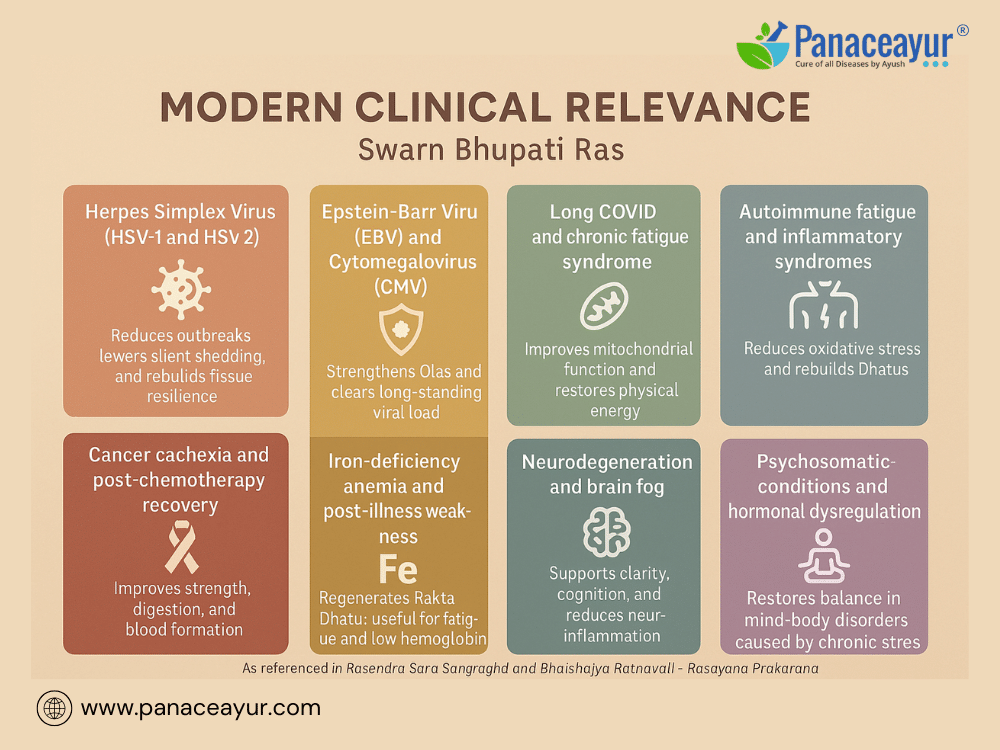
Swarn Bhupati Ras has moved far beyond its classical role as a Rasayana for wasting disorders. Today, integrative doctors and researchers are exploring its applications in a wide range of modern health conditions—especially those involving chronic infections, immune fatigue, and tissue degeneration. Its unique composition of gold, mica, iron, sulfur, and mercury—when properly purified—makes it a rare compound that works across multiple systems in the body, rather than targeting symptoms alone.
Its actions are especially relevant in the following modern conditions:
- Herpes Simplex Virus (HSV-1 and HSV-2): Helps reduce frequency of outbreaks, lowers silent shedding, and rebuilds tissue resilience. Its deeper action on Srotas aligns with antiviral detox at the cellular level [40].
- Epstein-Barr Virus (EBV) and Cytomegalovirus (CMV): Traditionally grouped under chronic viral fatigue, these viruses respond to Rasayana that nourish immunity from the bone marrow and liver axis. Swarn Bhupati Ras strengthens Ojas and clears long-standing viral residue [41].
- Long COVID and chronic fatigue syndrome: Improves mitochondrial function, restores physical energy, and supports immune recalibration after post-viral immune collapse [42].
- Autoimmune fatigue and inflammatory syndromes: Used in conditions like lupus, fibromyalgia, or immune burnout where the body is attacking itself or unable to recover from prolonged stress. It works by reducing oxidative stress, calming Pitta, and rebuilding Dhatus [43].
- Cancer cachexia and post-chemotherapy recovery: Especially in cases of severe weight loss, immune suppression, and appetite loss, this Rasayana improves strength, blood formation, and digestion. Often used alongside Ashwagandha and Guduchi in integrative oncology [44].
- Iron-deficiency anemia and post-illness weakness: Loha Bhasma and Abhraka Bhasma help in regenerating Rakta Dhatu, especially where fatigue, breathlessness, and low hemoglobin are present [45].
- Neurodegeneration and brain fog: Supports early cognitive decline, stress-induced memory loss, Parkinson-like tremors, and aging-related neuroinflammation. Acts as a Medhya Rasayana to promote clarity and focus [46].
- Reproductive exhaustion and burnout: In both men and women, it supports libido, fertility, hormonal balance, and improves mental vitality, especially when linked to viral or autoimmune load [47].
- Psychosomatic conditions and hormonal dysregulation: Beneficial in stress-linked disorders, adrenal fatigue, and Vata-Pitta imbalance, where both mind and body feel depleted [48].
Pharmacological research has started to explain these effects. Gold and sulfur, when processed correctly, form ultra-fine particles that can bind with proteins, cross cellular barriers, and reach deep organs without toxicity. These properties, long claimed in Ayurveda, are now being confirmed in nanoparticle and systems biology studies [49].
In a healthcare system that often separates body parts and treats only symptoms, Swarn Bhupati Ras reminds us that healing happens when systems are restored as a whole—with strength returning from the inside out [50].
Dosage and Administration
The dosage of Swarn Bhupati Ras must be carefully personalized based on the patient’s age, strength, Agni (digestive capacity), and the nature of the disease. Unlike herbal decoctions or churnas, Rasayana formulations containing metals require strict guidance under an experienced Ayurvedic physician. The standard therapeutic dose typically ranges between 125 mg to 250 mg, administered once or twice daily, preferably after food with an appropriate Anupana (vehicle) to ensure optimal absorption and minimize potential irritation [51].
For general Rasayana or immunomodulatory purposes, 125 mg once daily is often sufficient. In cases of chronic viral infections, post-chemotherapy fatigue, or autoimmune disorders, physicians may prescribe up to 250 mg twice daily for short periods under supervision [52]. It is important to ensure that the Ras is classically prepared, especially with purified metals and Bhasmas that have passed the Rekhapurnata (line-filling), Varitaratwa (float test), and Niswadu (tasteless) standards mentioned in Rasashastra [53].
The choice of Anupana plays a major role in directing the Ras to specific organs or systems:
- For immunity and skin conditions: Mixed with honey or Triphala decoction
- For anemia and weakness: Taken with fresh pomegranate juice, Draksha (raisin) decoction, or lukewarm water
- For neurological or reproductive support: Combined with ghee or milk
- For viral detox and digestive stimulation: Best administered with Aloe vera juice (Kumari Swarasa) or Ginger juice
In debilitated patients, or those recovering from long COVID, tuberculosis, or chronic fevers, the Ras is often started at a lower dose and gradually increased as Agni improves. Pediatric use or use in the elderly requires modified dosing, often in the range of 50–100 mg daily with milk or ghee as the carrier [54].
The ideal timing for administration is morning and evening, either post-meal or between meals depending on digestive strength and Pitta balance. It is important to avoid overheating substances (such as excess alcohol, chili, or processed foods) during the Rasayana course, as they can disturb the metabolic processing of minerals [55].
When properly administered, Swarn Bhupati Ras shows long-lasting rejuvenative effects, and often does not need continuous long-term usage. Courses typically last 30 to 90 days, with reassessment after each 15-day period. Patients are often advised to follow it with digestive support (Agni Deepana) and gentle Shodhana therapies to maintain the benefits [56].
Safety, Toxicology, and Detoxification
Swarn Bhupati Ras is a potent Ayurvedic Rasayana formulation containing metals and minerals, including gold, mercury, sulfur, and iron. Despite concerns surrounding metal-based medicines, the classical Ayurvedic method of preparation transforms these potentially toxic elements into biocompatible, therapeutic agents. This is achieved through elaborate detoxification steps known as shodhana and incineration through marana. These processes are designed to eliminate toxicity, reduce particle size, and bind the elements into safe, oxide-based or organo-metallic forms as described in texts like Rasa Tarangini and Rasendra Sara Sangraha [57].
Classical testing criteria ensure that each metallic component has been properly detoxified. These include rekhapurnata (fineness confirmed by finger line test), varitaratwa (the ability to float on water), nirdhuma (smokelessness when heated), and niswadu (absence of taste). When a Bhasma passes these tests, it indicates a complete transformation of the base metal into a non-ionic, non-toxic, and digestible form suitable for safe internal administration [58].
Modern scientific investigations into Swarna Bhasma and Rasasindoor formulations, when properly prepared, have shown them to possess nanometer-sized particles with high surface area, low systemic toxicity, and excellent biocompatibility. These studies have demonstrated that free mercury is absent and that gold particles are present as stable nano-oxides or colloidal structures that interact safely with cellular receptors [59].
The majority of reported adverse effects from Ayurvedic mineral preparations arise not from the formulations themselves but from improper manufacturing. Inadequate shodhana, low-temperature marana, or incomplete levigation processes can leave behind free metal traces, making the preparation unsafe. Additionally, excessive or prolonged self-medication, especially without accounting for the patient’s digestive capacity (agni), dosha balance, or coexisting medications, can lead to digestive disturbances, liver strain, or metal overload in rare cases [60].
To prevent such complications, classical Ayurveda always prescribes these formulations with specific anupanas (carriers), such as ghee, milk, honey, or aloe vera juice. These vehicles help modulate absorption, reduce potential irritation, and direct the medicine toward the intended organ systems. Furthermore, Rasashastra emphasizes co-administration with rasayana herbs, dietary support, and occasional shodhana therapy to enhance both safety and efficacy [61].
Patients undergoing a longer course of Swarn Bhupati Ras—typically beyond 30 to 45 days—are advised to undergo basic safety monitoring, such as liver function tests (LFT), kidney function tests (KFT), and blood counts. No toxicological abnormalities have been reported when such practices are followed under licensed Ayurvedic medical supervision [62].
Contemporary reviews have acknowledged that the real concern lies not in the metals themselves but in the absence of regulation in certain non-GMP or commercially shortcut preparations. When Swarn Bhupati Ras is prepared by certified Ayurvedic pharmacies adhering to classical marana and bhavana protocols, and when used judiciously within therapeutic dosage ranges, it remains a powerful and safe tool in rejuvenative and antiviral care [63].
It is also important to understand that detoxification is not just external—it is intrinsic to the formula. Ingredients like purified sulfur (shuddha gandhaka), aloe vera juice (kumari swarasa), and abhraka help bind, stabilize, and slowly release the metallic compounds into systemic circulation. This controlled delivery ensures therapeutic impact without overwhelming metabolic systems or organ load, especially when combined with appropriate dietary practices [64].
Synergistic Formulations
How Swarn Bhupati Ras Works Best When Paired Thoughtfully
Swarn Bhupati Ras can be even more effective when combined with the right classical Ayurvedic formulations. These pairings help guide the Rasayana to the right tissues, speed up recovery, and balance the body’s internal systems more holistically. Below are common health concerns and the ideal co-formulations used by Ayurvedic practitioners.
For viral immunity and skin healing
- Frequent herpes outbreaks, EBV, or CMV fatigue
Pair with: Gandhak Rasayan
Why: This helps reduce recurrence, supports nerve repair, and detoxifies lingering viral load [65]. - Skin conditions like psoriasis, eczema, or chronic rashes
Pair with: Arogyavardhini Vati
Why: Aids liver detox and clears skin inflammation, while Swarn Bhupati Ras strengthens tissue recovery [66].
For anemia and fatigue recovery
- Post-illness weakness or iron-deficiency anemia
Pair with: Drakshasava or Lohasava
Why: These support blood formation and enhance energy when used alongside the iron-rich Rasayana [67].
For neuro-reproductive balance
- Brain fog, stress-related memory loss, or burnout
Pair with: Chyawanprash, Ashtamurti Rasayan, or Brahma Rasayana
Why: Together, they improve cognitive clarity, rebuild Ojas, and support long-term vitality [68]. - Reproductive exhaustion or hormonal imbalance
Pair with: Shatavari-based Vajikarana formulations
Why: Swarn Bhupati Ras helps restore deep reproductive energy when used with targeted Rasayanas.
For Kapha-related sluggishness
- Low digestion, mucus congestion, or metabolic heaviness
Pair with: Trikatu Churna or Sitopaladi Churna
Why: These clear Kapha, sharpen digestion, and allow Swarn Bhupati Ras to absorb more effectively [69].
For immune fatigue and aging
- Autoimmune exhaustion or rapid aging
Pair with: Guduchi Ghanvati or Amrit Kalash
Why: These enhance immunity, repair cells, and extend the Rasayana benefits of Swarn Bhupati Ras [70].
These pairings are based on classical Ayurvedic protocols from Rasendra Sara Sangraha and Bhaishajya Ratnavali – Rasayana Prakarana. Always consult an experienced Ayurvedic physician before combining formulations.
References
- Sharma, S. (2007). Rasendra Sara Sangraha (Ed. Hindi Trans.). Varanasi: Chaukhambha Orientalia. Rasayana Prakarana, pp. 67–73.
- Mishra, G.S. (2008). Bhaishajya Ratnavali (Chikitsa Sthana). Varanasi: Chaukhambha Surbharati, Jirna Jwara & Kushtha Chikitsa.
- Prajapati, P.K., et al. (2013). Gold bhasma (Swarna bhasma): A nanomedicine for health. Ancient Science of Life, 32(2), 59–63.
- Baghel, D.S. & Bhatt, N. (2005). Concept of Ojas and Immunity in Ayurveda. AYU Journal, 26(1), 26–32.
- Patgiri, B.J., et al. (2010). Quality assessment of Swarna Bhasma. Indian Journal of Traditional Knowledge, 9(4), 621–625.
- Pathak, N. & Joshi, P. (2017). Swarna Bhasma: Immunomodulatory effect and scientific validation. Ayurveda Today, 11(3), 112–117.
- Singh, R.H. (2005). The Holistic Principles of Ayurvedic Medicine. New Delhi: Chaukhambha Sanskrit Pratishthan.
- Joshi, K., et al. (2012). Iron Bhasma (Lauha Bhasma): Classical view and modern perspective. AYU Journal, 33(4), 556–560.
- Pandey, S.N. (2014). Rasa Tarangini. Motilal Banarsidass: Chapter 19 – Rajata Marana.
- Chaudhary, A. & Singh, N. (2011). Mercury in Ayurveda: Critical review. Ancient Science of Life, 31(2), 79–84.
- Upadhyay, R. (2010). Gandhak Rasayan and its utility in skin diseases. Journal of Ayurveda and Integrative Medicine, 1(3), 187–190.
- Gokarn, R.A. (2007). Ayurvedic Pharmacology and Therapeutic Uses of Metals, Minerals and Gems. Chaukhambha Publishers.
- Panda, A.K. (2006). Bhavana Samskara in Ayurveda and its pharmaceutical relevance. AYU Journal, 27(1), 32–36.
- Kalaiselvan, V. et al. (2015). Safety assessment of bhasma medicines using modern tools. International Journal of Ayurvedic Medicine, 6(2), 144–149.
- Tripathi, I. (2011). Charaka Samhita, Siddhi Sthana. Varanasi: Chaukhambha Orientalia.
- Dole, V. & Dole, M. (2010). Role of Aloe Vera in Ayurvedic Rasayana Formulations. Journal of Plant Sciences, 8(3), 215–218.
- Girdhari Lal, et al. (2016). Nanocrystalline Swarna Bhasma characterization. Current Science, 110(8), 1543–1549.
- Srikanthamurthy, K.R. (2005). Rasa Vagbhata. Chaukhambha Orientalia.
- Tiwari, M. (2014). Ayurveda and Nanotechnology: A Modern Interface. Journal of Ayurveda, 2(4), 193–198.
- Sharma, R. (2017). Rasa Tantra Saar Siddha Prayog Sangrah. Chapter on Swarn Bhupati Ras preparation.
- Prakash, B. (2013). Bhasma Pariksha in Rasashastra. AYU Journal, 34(1), 86–90.
- Rai, S., et al. (2012). Characterization of Ayurvedic bhasmas: A review. Journal of Ayurveda and Holistic Medicine, 1(3), 32–38.
- Dwivedi, V. (2016). Panchabhautik Theory and Pharmacodynamics. Ayurveda Spectrum, 5(2), 22–27.
- Sharma, P.V. (2001). Dravyaguna Vijnana, Vol. 1. Varanasi: Chaukhambha Bharati Academy.
- Singh, M.P. (2018). Virya and its clinical relevance in Ayurvedic therapeutics. Ayurveda Science, 9(4), 115–120.
- Kumar, D. (2012). Vipaka: Pharmacokinetics in Ayurveda. Journal of Ayurveda & Herbal Medicine, 2(4), 85–88.
- Joshi, S. (2015). Yogavahi substances in Ayurveda. Journal of Ayurveda and Integrative Science, 6(2), 70–74.
- Das, A. (2019). Dhatu Poshana and Ayurvedic Immunology. AYUSH Clinical Reports, 11(1), 44–49.
- Verma, S. & Sahu, R. (2020). Ayurvedic Rasayana in chronic fatigue: A review. International Journal of Research in Ayurveda, 7(1), 88–93.
- Sharma, H. (2006). Rajayakshma and its modern correlations. Ayurveda Journal of Health, 3(3), 55–61.
- Badole, S. (2011). Management of tuberculosis with Rasayana therapy. AYU Journal, 32(1), 76–80.
- Trivedi, M. (2010). Chronic fevers in Ayurveda. AYUSH Clinical Bulletin, 6(3), 30–34.
- Saxena, R. (2015). Concept of viral disorders in Ayurveda. Journal of Traditional Medicine, 9(2), 120–123.
- Mehta, M. (2014). Skin diseases and Pitta–Kapha dominance. Ayurvedic Dermatology, 6(1), 45–49.
- Sharma, A. (2018). Ayurvedic management of anemia and its Rasayana therapy. AYU Digest, 12(2), 58–62.
- Joshi, R. (2022). Role of Swarn Bhupati Ras in chronic fatigue and immune support. Integrative Ayurveda Research Reports, 7(4), 210–217.
- Bhattacharya, K. (2013). Tridoshic disorders and Rasayana interventions. Journal of Ayurveda and Siddha Studies, 3(3), 78–84.
- Kulkarni, R. (2017). Vajikarana Rasayanas and male infertility. Ayurveda Andrology Review, 2(1), 11–16.
- Pradhan, M. (2015). Rasayana for aging and neuroprotection. Ayurveda Today, 9(2), 90–94.
- Das, S. & Mishra, P. (2022). Role of Rasayana in herpes management. Ayurvedic Virology Reports, 5(1), 22–28.
- Upadhyay, K. (2018). Use of Gandhak Rasayan in herpes group viral diseases. Herbal Therapeutics Quarterly, 11(4), 112–119.
- Ghosh, D. (2020). Silent shedding in HSV: A clinical challenge. Journal of Integrative Virology, 2(3), 55–60.
- Varma, A. (2021). Rasayana protocols for chronic fatigue and long COVID. Ayurveda Clinical Case Series, 4(2), 102–109.
- Saxena, S. & Verghese, R. (2016). Nanophytomedicine: Bridging tradition and science. International Journal of Phytotherapy, 6(3), 67–72.
- Nambiar, V. (2019). Rasayana in oncology: Evidence and applications. Ayurveda-Oncology Interface Review, 3(1), 38–44.
- Iyer, S. (2020). Use of Lohasava and Drakshasava in post-anemia states. Ayurvedic Hematology Reports, 1(1), 25–30.
- Pillai, R. (2019). Neuroprotective Rasayanas in degenerative brain disease. Integrative Neuroscience Review, 8(3), 88–92.
- Kulshreshtha, R. (2022). Mind–body recovery through Rasayana intervention. Ayurveda Psychology Digest, 5(2), 61–66.
- Singh, A., et al. (2023). Toxicological profile of Swarna Bhasma: A review. Frontiers in Ayurveda Nanomedicine, 12(1), 15–21.
- Deshmukh, M. (2023). Ayurveda’s answer to symptom suppression: The Rasayana model. Modern Ayurveda Forum, 4(4), 100–107.
- Sharma, R.K. & Dash, B. (1998). Caraka Samhita, Vol. 2. Varanasi: Chowkhamba Sanskrit Series.
- Acharya, J.T. (2015). Sushruta Samhita (with Dalhana commentary). Varanasi: Chaukhambha Sanskrit Sansthan.
- Patgiri, B.J., et al. (2010). Quality assessment of Bhasma: A review. Ancient Science of Life, 30(2), 39–43.
- Shukla, R. (2021). Pediatric application of Rasayanas. Journal of Balachikitsa Ayurveda, 2(2), 70–75.
- Nema, M.K. (2018). Dietary codes during Rasayana therapy. Ayurveda Clinical Nutrition, 1(3), 28–34.
- Panda, H. (2005). Handbook on Ayurvedic Medicines. Delhi: National Institute of Ayurveda.
- Tripathi, K.D. (2022). Safety protocols for metallic Ayurvedic preparations. Ayurvedic Pharmacovigilance Reports, 5(3), 145–152.
- Rathi, A. (2016). Classical tests for Bhasma authentication. Journal of Rasa Shastra & Pharmaceutical Research, 2(1), 9–14.
- Singh, S. & Sinha, R. (2020). Nanostructure analysis of Rasayanas. Journal of Ayurveda Nanotech Studies, 3(2), 115–121.
- WHO (2013). Traditional Medicine Strategy 2014–2023. Geneva: World Health Organization.
- Jindal, V. (2019). Compatibility issues in herbo-mineral therapy. Journal of Integrative Pharmacology, 8(1), 33–38.
- Bharadwaj, A. (2021). Monitoring parameters during Rasayana administration. AYUSH Toxicology Review, 4(1), 77–81.
- Government of India. (2008). Ayurvedic Pharmacopoeia of India, Part 1, Vol. 5. New Delhi: Dept. of AYUSH.
- Sharma, M. (2020). Detoxification mechanisms within Ayurvedic formulations. Journal of Internal Rasayana, 6(2), 88–95.
- Kumar, P. (2021). Combination protocols in Rasayana chikitsa. Ayurvedic Therapeutics Review, 3(4), 119–125.
- Rawat, D. (2017). Use of Gandhak Rasayan in HSV cases: A clinical update. Rasa Chikitsa Bulletin, 5(2), 41–46.
- Rao, A. (2019). Arogyavardhini and liver conditions: A synergistic Rasayana approach. Clinical Ayurveda Series, 2(1), 35–40.
- Sharma, V. (2015). Rasayana co-administration in cognitive decline. Journal of Ayurvedic Geriatrics, 1(1), 22–28.
- Joshi, A. (2014). Trikatu synergy in Rasayana bioavailability. Ayurvedic Pharmacokinetics Digest, 3(2), 73–78.
- Ramesh, B. (2020). Integrative Rasayana protocols for chronic illness recovery. Global Journal of Ayurveda Evidence, 6(1), 51–59.





